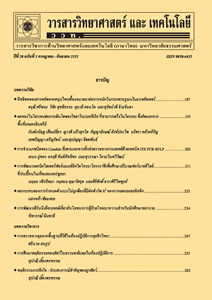การศึกษาเบื้องต้นของเครื่องหมาย SSR (simple sequence repeat) ที่พัฒนาจากการวิเคราะห์ลำดับเบสยุคใหม่ในสบู่ดำ (Jatropha curcas L.)
Main Article Content
Abstract
บทคัดย่อ
สบู่ดำเป็นหนึ่งในพืชหลายชนิดที่เป็นพลังงานชีวภาพและเป็นตัวเลือกที่สำคัญในการนำไปใช้ทดแทนการใช้น้ำมันดีเซล ดังนั้นความเข้าใจความหลากหลายทางพันธุกรรมของสบู่ดำจึงเป็นสิ่งสำคัญในการเก็บรวบรวมเชื้อพันธุ์และการวางแผนสำหรับการปรับปรุงพันธุ์ เครื่องหมาย simple sequence repeat (SSR) 92 เครื่องหมาย ที่พัฒนาโดยวิธีการหาลำดับเบสใหม่ด้วยวิธี pyrosequencing ได้ถูกนำมาวิเคราะห์และใช้สำหรับการวิเคราะห์ความหลากหลายทางพันธุกรรมของสบู่ดำสายพันธุ์ที่เก็บมาจากภูมิภาคต่างๆ ในประเทศไทย และนำเข้าจากต่างประเทศ ผลการวิเคราะห์พบว่ามี 24 เครื่องหมาย ที่แสดงพอริมอร์ฟิซึมในสบู่ดำที่นำมาทดสอบ มีค่า polymorphic information content (PIC) อยู่ระหว่าง 0.02 ถึง 0.39 ซึ่งมีค่าเฉลี่ยเท่ากับ 0.16 และมีค่าดัชนีความเหมือนอยู่ระหว่าง 0.32 ถึง 1.00 เมื่อวิเคราะห์ความสัมพันธ์ทางพันธุกรรมโดยใช้ค่าดัชนีความเหมือน พบว่าสามารถจัดสบู่ดำออกได้เป็น 4 กลุ่ม โดย 2 สายพันธุ์ สบู่ดำที่ไม่มีพิษจากเม็กซิโกและ 2 สายพันธุ์ จากอเมริกาถูกแยกออกจากพันธุ์สบู่ดำอื่นอย่างชัดเจนคำสำคัญ : สบู่ดำ; ความหลากหลายทางพันธุกรรม; เอสเอสอาร์
Abstract
Jatropha curcas L. is one of many plants that holds a great deal of promise as a biofuel and could emerge as a major alternative to diesel. Understanding diversity of J. curcas is important for germplasm collection and planning for breeding programs. Ninety two simple sequence repeat (SSR) markers developed by next generation pyrosequencing were characterized and used for evaluation of genetic diversity of J. curcas accessions collected from different regions within Thailand and introduced from other countries. Of the primer pairs tested, 24 identified polymorphism among all of J. curcasaccessions examined. Polymorphic information content (PIC) value per SSR primer ranged from 0.02 to 0.39 with the average of 0.16. The similarity coefficient ranged from 0.32 to 1.00. Cluster analysis base on genetic similarity coefficient indicated four clusters which two non-toxic from Mexico and two USA accessions were clearly differentiated from other accessions.
Keywords: Jatropha curcas L.; genetic diversity; simple sequence repeat (SSR)


